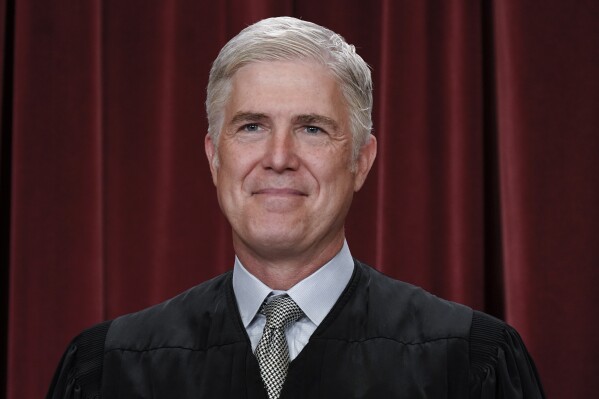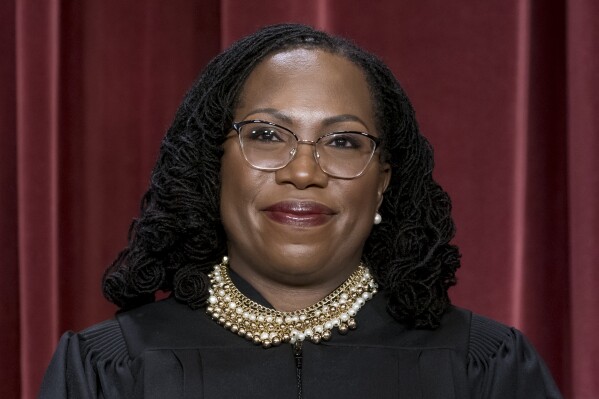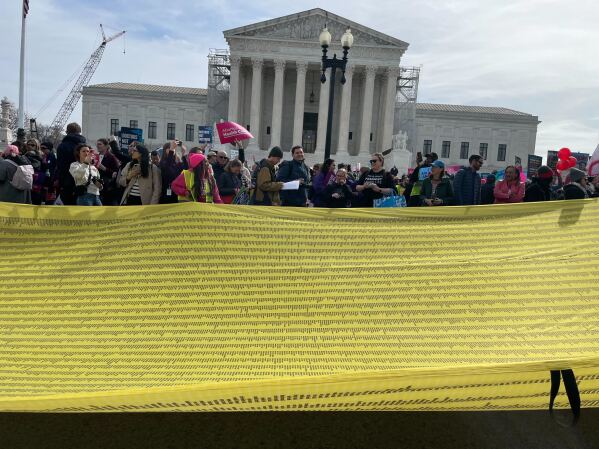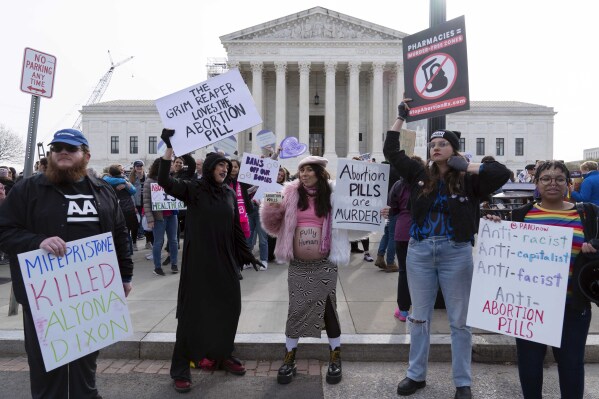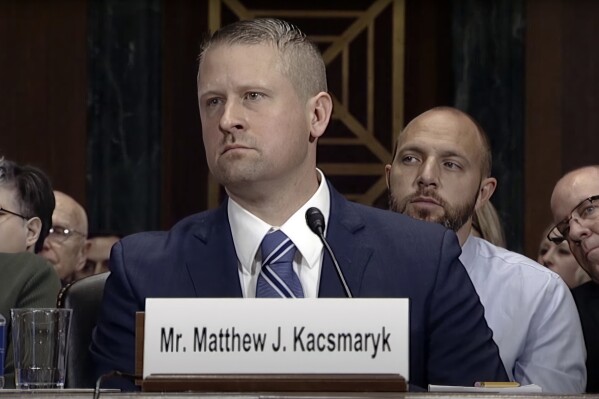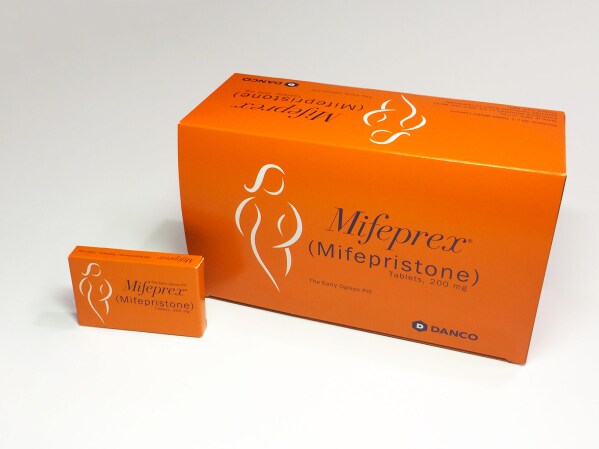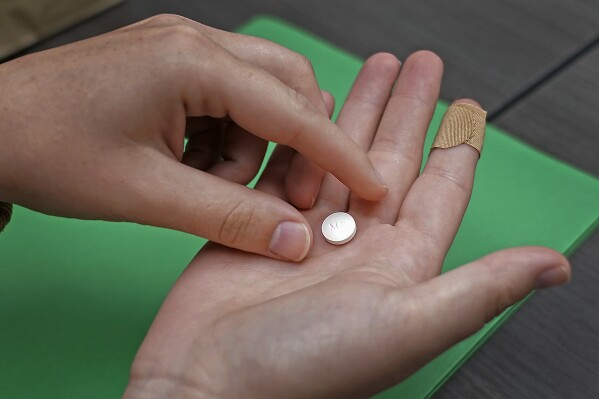Highlights from the Supreme Court’s hearing on abortion pill mifepristone
The Supreme Court seems likely to preserve access to a medication that was used in nearly two-thirds of all abortions in the U.S. last year, in the court’s first abortion case since conservative justices overturned Roe v. Wade two years ago.
The hearing may be over, but there’s still lots to catch up on. See what you missed below and follow the AP’s latest coverage on the Supreme Court and abortion.
The U.S. Supreme Court is examining the issue of abortion this week as it hears arguments over whether to limit access to mifepristone, a pill used in the most common way to end a pregnancy.
In 90 minutes of arguments, the justices appeared likely to preserve access to the drug, with even conservative justices voicing skepticism over the lawsuit’s scope.
Here’s what to know:
— How safe is mifepristone? The central dispute in today’s case is whether the Food and Drug Administration overlooked serious safety problems when it made mifepristone easier to obtain, including through mail-order pharmacies. The AP dug into the pill’s safety here.
— What’s at stake? If the Supreme Court sides with the conservative groups suing the FDA, it would mean patients would no longer be able to receive mifepristone through the mail, among other major restrictions. Beyond abortion, the ruling could upend pharmaceutical regulatory processes.
— When will the Supreme Court issue a decision? The exact timing is unclear, but the court almost always issues its decisions by early summer, usually before the end of June.
Central to the hearing have been questions over whether doctors are allowed a “conscience objection” to not prescribe or use mifepristone when assisting in an abortion.
The debate over conscience objections began with Justice Kavanaugh asking Solicitor General Prelogar, “Under federal law, no doctors can be forced against their consciences to perform or assist in an abortion, correct?”
“Yes, we think that federal conscience protections provide broad coverage here,” Prelogar said.
However, the plaintiffs, represented by the conservative group Alliance Defending Freedom, argued that doctors are often unable to object in emergency situations that require immediate care.
“These are life-threatening situations in which the choice for a doctor is either to sub out and try to find someone else or treat the woman,” Hawley, the group’s lawyer, said.
Justices, including Justices Jackson and Kagan, appeared skeptical of this argument and pressed plaintiffs to point to an instance where a doctor attempted to object but was unable to. Hawley acknowledged none of the doctors who submitted declarations had been required to perform an abortion using mifepristone after objecting to do so.
Many justices across the ideological spectrum seemed unconvinced that plaintiffs have the legal standing to challenge the FDA’s approval of mifepristone.
Standing relies on whether the person or group suing has been or is likely to be harmed. The doctors who brought the suit don’t perform abortions but argue they have the legal grounds to sue because they may treat emergency room patients experiencing serious complications from mifepristone.
In response to a question from Justice Thomas, Solicitor General Prelogar said people opposing abortion would not have legal standing in this case.
“But the reason is because those people aren’t regulated in any relevant way under FDA’s decisions here,” she said. “Take the responding doctors — they don’t prescribe mifepristone. They don’t take mifepristone. The FDA is not requiring them from doing or refraining from doing anything. They aren’t required to treat women to take mifepristone.”
Justice Alito, however, appeared skeptical of arguments that the doctors don’t have the legal standing to sue.
“Is there anybody who can sue and get a judicial ruling on whether what FDA did was lawful?” Alito asked. “And maybe what they did was perfectly lawful, but shouldn’t somebody be able to challenge that in court?”
Alito wrote the 2022 ruling that overturned Roe v. Wade. He and Thomas would have allowed some restrictions on mifepristone to take effect while the case proceeded but were outvoted by the other justices.
Attorney Erin Hawley tried to convince the justices that a nationwide rule curtailing mifepristone’s use was appropriate but ran into some skepticism.
She was repeatedly interrupted by Justice Gorsuch, who voiced objections to such sweeping injunctions.
The case “seems like a prime example of turning what could be a small lawsuit into a nationwide legislative assembly on an FDA rule or any other federal government action,” said Gorsuch, one of the three judges whose swing votes may decide the fate of mifepristone access.
Normally when a court issues an injunction about a government policy, it only applies to the individuals or groups in the case. But in recent years, a growing number of lower court judges have issued so-called “universal injunctions,” blocking nationwide policies.
Gorsuch noted that there have been roughly 60 such rulings in the last four years.
Chief Justice Roberts also seemed skeptical that a ruling reversing the FDA’s scientific judgments was necessary.
“Why can’t the court specify that this relief runs to precisely the parties before the court as opposed to looking to the agency in general and saying, ‘agency, you can’t do this anywhere’?”
The Supreme Court will again wade into the fractious issue of abortion this week when it hears arguments over a medication used in the most common way to end a pregnancy, a case with profound implications for millions of women no matter where they live in America and, perhaps, for the race for the White House.
The group of abortion opponents has concluded its rally. Members of the group, many of whom wore white lab coats, are slowly making their way away from the court. The pro-abortion rally is still happening but people are trickling out.
The competing rallies outside the court attracted many of the groups leading legal and political clashes over abortion rights.
The groups talked over each other from loudspeakers set up on the sidewalk and waved clashing signs in close quarters, but there were only a few direct confrontations. Police officers moved in to contain one protester who was trying to agitate abortion opponents. She subsequently withdrew.
Erin Hawley’s husband, Republican Sen. Josh Hawley of Missouri, was seated in the audience looking on as his wife argued her case for the Alliance Defending Freedom. The senator was joined by at least one of their children, a young son.
The crowd outside the court is mostly filled with people advocating for abortion rights, and organizers say they are encouraged by the turnout. They say it shows people are becoming increasingly engaged in supporting abortion rights.
Before court wrapped, Justice Jackson asked Hawley whether courts and lawyers should be trying to parse scientific studies reviewed by the FDA.
“What deference do we owe them at all with respect to their assessment that these studies,” show mifepristone is safe and effective? Jackson asked.
The question of FDA’s authority is key to the case before the court. For more than a half-century, courts have generally deferred to the FDA and other federal agencies on matters of complex scientific expertise. Drugmakers argue this framework provides essential stability and predictability needed to conduct time-consuming, expensive research.
But recent court decisions, including those by the Supreme Court, have chipped away at the authority designated to federal regulators.
After 90 minutes, the Supreme Court has finished hearing arguments in the case over access to the abortion medication mifepristone.
The justices appeared likely to preserve access to the drug, with even conservative justices voicing skepticism over the lawsuit’s scope.
The high court is expected to hand down a decision by the summer.
Gorsuch said the case “seems like a prime example of turning what could be a small lawsuit into a nationwide legislative assembly on an FDA rule or any other federal government action.”
Roberts asked, “Why can’t the court specify that this relief runs to precisely the parties before the court as opposed to looking to the agency in general and saying, ‘agency you can’t do this anywhere’?”
Erin Hawley, lawyer for the Alliance Defending Freedom, is quoting from the FDA’s drug prescribing information to try and emphasize the harms linked to mifepristone. Among other figures, she notes that the label states that between 2.9% and 4.6% Of women taking the drug go to the emergency room.
Researchers have dug into this figure and shown that many women who go to the ER simply have questions or concerns about how the drug is working. The drug causes heavy bleeding as part of the process of eliminating a pregnancy.
Some women go to the ER because they don’t want to tell their primary physician they had an abortion, researchers note. The FDA label states that only a fraction of a percent of women are ever hospitalized.
Outside the court, the Alliance Defending Freedom is arguing the case for abortion opponents.
“Women deserve the in-person ongoing care of a doctor when taking high-risk drugs,” said Julie Marie Blake, the group’s senior counsel. “But the FDA has failed its responsibility to protect women and girls by removing any in-person care from chemical abortion drugs.”
Dr. Susan Bane, an OB-GYN who is opposed to abortion, said that in-person consultations with physicians were important for diagnosing an ectopic pregnancy, which is when a fertilized egg implants and grows outside the main cavity of the uterus.
“If a woman were to take the abortion drug and she had an ectopic pregnancy, it wouldn’t treat it. She actually may go home and have the same symptoms thinking she’s just having the abortion, and she’s actually rupturing and ectopic, which is life-threatening.”
There are rare occasions when mifepristone can cause dangerous, excessive bleeding that requires emergency care. But medical professionals call it “among the safest medications” ever approved by the FDA. Any decision by the court to restrict it would impact abortion access.
“The other side that’s arguing this is about safety — it’s not,” said Ryan Stitzlein, a vice president of government relations for Reproductive Freedom for All. “This is about ultimately ending abortion in this country.”
Justice Kavanaugh asked Solicitor General Prelogar, “Under federal law, no doctors can be forced against their consciences to perform or assist in an abortion, correct?”
“Yes, we think that federal conscience protections provide broad coverage here,” Prelogar said.
Why can’t the doctors who oppose abortion simply opt out of being involved with mifepristone, rather than suing to restrict access to the entire country?
It’s a key question for the plaintiffs, represented by the group Alliance Defending Freedom. Justices Jackson and Gorsuch both raised questions about whether a “handful” of doctors could bring about an overly broad result.
Attorney Erin Hawley argued that doctors can’t raise those kinds of objections during an emergency situation and a patient needs help right away — and doctors might not immediately know if abortion medication is involved.
“I don’t want to hypothesize,” Jackson said. “Can you point me to any place in the declaration where a declarant states that they attempted to object but were unable to?”
Hawley acknowledged none of the doctors pointed to specific instances where they were required to perform an abortion after objecting to do so. But she argued that the doctors are not “necessarily able to object” due to the impracticality of emergency room situations.
Jessica Ellsworth, an attorney representing drug maker Danco Laboratories, mentioned the retraction of studies claiming to show the harms of mifepristone.
Two of three studies recently retracted by medical publisher Sage Perspectives were cited in the pivotal Texas court ruling that has threatened access to the pill.
Both were published in the journal Health Services Research and Managerial Epidemiology and supported by the Charlotte Lozier Institute, part of an advocacy group that seeks to end access to abortion.
In a retraction notice, Sage Perspectives said a reader contacted the journal with concerns about the presentation of some of the data, possible “defects” in the selection of the data and whether authors’ affiliations with anti-abortion advocacy organizations present conflicts of interest that should have been disclosed.
Sage said in a statement that it asked two experts to conduct an independent post-publication peer review, which found the conclusions “were invalidated in whole or in part” for several reasons, including problems with the study design and methodology and errors in the analysis of the data.
Jessica Ellsworth, an attorney representing the New York-based Danco Laboratories, which makes mifepristone, began her arguments by emphasizing the risk to pharmaceutical regulatory processes that could be caused by this case.
“I think this court should think hard about the mischief it would invite if it allowed agencies to start taking action based on statutory responsibilities that Congress has assigned to other agencies,” she said.
Justices asked how the legal challenge would affect the company. Mifepristone is the only product Danco Laboratories is currently marketing.
“We are prevented from selling our product in line with FDA’s scientific judgments about the safe and efficacious use of the drug,” Ellsworth said.
Justice Ketanji Brown Jackson questioned whether there was a “significant mismatch” between the injury that abortion opponents are claiming and the potential effects of the lawsuit that restrict access to mifepristone nationwide.
Doctors who don’t want to be involved in abortions already have protections under federal law, Prelogar argued.
Justice Amy Coney Barrett asked the Biden administration about what types of injuries or adverse events related to mifepristone must be reported to the FDA.
The anti-abortion group challenging mifepristone’s use alleges that the FDA is overlooking thousands of problems related to the drug because it only requires doctors to report deaths and certain other serious injuries. That requirement is standard for nearly all prescription drugs in the U.S.
Prelogar argues the premise of the question is incorrect because FDA reviewed studies showing that rates of adverse events are very rare with mifepristone, whether it is dispensed in-person or through the mail after a telehealth visit.
Per Prelogar, “That’s a question Congress has entrusted to FDA.”
In response to questions about the process of removing previous mifepristone access restrictions, Prelogar explained that the “FDA is instructed to take into account burdens on the health care delivery system as well.”
Since approving mifepristone in 2000, the FDA made changes to the drug’s prescribing guidelines in 2016 and 2021. In 2016, the agency extended the suggested use of mifepristone from seven weeks through 10 weeks of pregnancy, changed the recommended dosage needed for medication abortion, and began allowing clinicians such as nurses and physician assistants to prescribe it. In 2021, the Biden administration temporarily removed in-person dispensing requirements during the COVID-19 pandemic, opening the door for telemedicine medication abortions.
“It looked at a variety of sources of data to conclude that ... it was not necessary to keep these burdens in place to ensure safe use,” Prelogar said.
Justice Alito asked Solicitor General Prelogar why the FDA didn’t consider the Comstock Act, a 19th-century anti-vice law that has been revived by anti-abortion advocates seeking to block the delivery of mifepristone through the U.S. mail.
“Shouldn’t the FDA at least have considered that and given some sort of explanation?” Alito asked.
Prelogar answered that the law is not in “FDA’s lane” and it wasn’t “FDA’s responsibility to consider it.”
In recent years, anti-abortion groups and state officials have seized on Comstock to try and shut off the flow of abortion pills.
“Is there anybody who can sue and get a judicial ruling on whether what FDA did was lawful?” Alito asked. “And maybe what they did was perfectly lawful, but shouldn’t somebody be able to challenge that in court?”
Alito wrote the 2022 ruling that overturned Roe v. Wade. He and Thomas would have allowed some restrictions on mifepristone to take effect while the case proceeded but were outvoted by the other justices.
The justices’ first questions for the Biden administration centered around their argument that abortion opponents didn’t have legal standing to challenge access to mifepristone in this case
Justices Clarence Thomas and Samuel Alito asked about whether there could be a situation where someone might be able to sue over the FDA’s approval of the drug.
Solicitor General Prelogar maintained that the drug has been shown to be safe and the plaintiffs don’t come within “100 miles” of having the legal right to sue.
Prelogar is arguing the plaintiffs lack standing, which could “severely disrupt the federal system for developing and approving drugs, harming the agency and the pharmaceutical industry.”
She said an adverse ruling could also “inflict grave harm on women across the nation,” forcing some women to undergo more invasive procedural abortions or not be able to access the drug at all.
“The FDA approved mifepristone based on the agency’s scientific judgment that the drug is safe and effective,” Prelogar said. “Millions of Americans have used mifepristone safely in their pregnancies. Respondents may not agree with choice, but that doesn’t give them Article 3 standing or a legal basis to upend the regulatory scheme.”
Listen along live with the feed at the top of the page.
The abortion pill mifepristone is more accessible today than at any point since its approval in 2000.
A 2021 change by the FDA allowed patients to receive the pills via mail after a telehealth consultation with a medical professional. A related change allowed large, brick-and-mortar pharmacies to dispense the drug for the first time.
Earlier this month national pharmacies CVS and Walgreens each said they would soon begin dispensing mifepristone in several states where abortion is legal.
For more than 20 years, the FDA labeling on mifepristone had limited dispensing to a small number of certified doctor’s offices and clinics and users were required to pick the drug up in person.
When William Rehnquist was chief justice from 1986 until his death in 2005, Supreme Court arguments lasted only their allotted hour, almost to the second. Rehnquist was a stickler for time and would cut lawyers off mid-sentence when the red light went on at their podium.
But times have changed.
Current Chief Justice John Roberts is more lenient — and in any event, changes to the structure of the arguments first introduced during the pandemic have lengthened arguments.
So while the court has allotted one hour to hear the case over access to mifepristone, the arguments could last twice as long, or more.
Thomas was famously silent during arguments for years at a time because he said he relied on written briefs and thought his colleagues interrupted too much.
But when the court started hearing cases remotely during the COVID-19 pandemic, the justices altered their practice and asked questions one by one, instead of the usual free-for-all. Even after they returned to the courtroom, the justices have informally agreed to allow Thomas, the longest-serving member of the court, to go first.
He has asked questions at every argument session he’s attended since the court’s first remote arguments in May 2020.
Today’s Supreme Court case was originally filed in the Texas panhandle city of Amarillo.
All cases filed in the city come before a single federal judge, Matthew Kacsmaryk.
Before being appointed as a judge by former President Trump, he was an attorney for a religious liberty legal group with a history of pushing conservative causes.
Kacsmaryk’s unprecedented ruling last year, which would have halted FDA approval of the abortion medication mifepristone, deepened concerns among some experts about “judge shopping.
”Plaintiffs across the political spectrum have long sought out judges who they think will be sympathetic, but major cases arising out of single-judge divisions in Texas and elsewhere have drawn concerns from experts.
With the fate of abortion pills uncertain, demand for them has peaked in recent years.
A research letter published in JAMA Internal Medicine in early January looked at requests for the pills from people who weren’t pregnant and sought them through Aid Access, a European online telemedicine service that prescribes them for future and immediate use.
The national average for daily requests shot up nearly tenfold after news of the impending overturn of Roe v. Wade leaked in May 2022, going from an average of 25 daily requests in the eight months before the leak to an average of 247 after the leak.
The outcome of the mifepristone case hinges on the votes of Justices Amy Coney Barrett, Neil Gorsuch and Brett Kavanaugh, former President Donald Trump’s three Supreme Court appointees. They were in the bare, five-vote conservative majority that overturned Roe v. Wade nearly two years ago. But they have said nothing about abortion since. Justices Samuel Alito and Clarence Thomas, the other members of the majority in 2022, have already said they would have let a lower-court ruling rolling back access to mifepristone take effect while the legal fight continues.
Here’s a look at what the polling says:
— About half of U.S. adults (54%) in a KFF poll conducted in February said they had heard of the drug mifepristone, up from 31% in January the year before.
— Most U.S. adults (55%) believe medication abortion pills are very or somewhat safe when taken as directed by a doctor, according to a KFF poll conducted in May 2023. Roughly 7 in 10 Democrats (72%) say medication abortion is safe. About 6 in 10 Independents (58%) and 4 in 10 (40%) Republicans agree. About as many Republicans (45%) say they are not sure about the safety of medication abortion.
— There is a broad lack of knowledge about how mifepristone is used outside of the context of abortion. About 2 in 10 (19%) U.S. adults are aware that medication abortion pills can be used to treat a miscarriage, while around 7 in 10 (73%) are unsure.
It’s a lively scene outside the Supreme Court with demonstrators occupying the streets surrounding the building. Several groups are chanting in support of abortion rights while smaller groups are marching and chanting in opposition to abortion.
The police have blocked traffic surrounding the court as well.
In front of the court, abortion opponents are giving speeches while another abortion-rights group, Aid Access, has brought robots that can deliver mifepristone as part of their mission to make the pills available in all 50 states.
Approved by the FDA in 2000, mifepristone is a component of treatment and management for early pregnancy loss or miscarriage by the U.S. Department of Health and Human Services, the American Medical Association and the American College of Obstetricians and Gynecologists.
In amicus briefs filed in support by the FDA, leading medical associations and health experts have touted the drug’s decades-long safety records and studies showing it to be safer than common drugs such as Tylenol and Viagra.
Major adverse reactions to the drug are “exceedingly rare,” occurring in about 0.3% of cases, and the risk of death is near zero, according to the American Medical Association.
It is among “the most studied medications” prescribed in the country, per an amicus brief filed by the AMA, American Academy of Family Physicians and other organizations. Evidence of the drug’s safety and effectiveness is “overwhelming” and “on par with common painkillers like ibuprofen and acetaminophen,” or Tylenol, per the brief.
The Democratic senator from Massachusetts said the case is not about whether medically induced abortions are safe but “Donald Trump and the Republican Party marching us to a full-on abortion ban.”
In a conference call organized by President Biden’s campaign, she noted that the FDA first found in 2000 that Mifepristone “is safe and effective” and that Americans had been using it successfully ever since.
Warren said that abortion bans supported by Republicans have proved so politically unpopular — even in deeply red states like Kansas and Kentucky — the party’s top leaders “have gone to the courts as if they know better than the scientific experts at the FDA about the safety of medication abortion.”
Since 2000, the FDA has repeatedly reaffirmed mifepristone’s safety and further eased restrictions on it, culminating in a 2021 decision allowing the pills to be sent through the mail.
The Guttmacher Institute, a research group that supports abortion rights, said about 642,700 medication abortions took place in 2023, accounting for 63% of abortions in the formal health care system. That’s up from 53% in 2020.
One reason? Telehealth. Doctors say it’s more convenient for patients and helps clinics meet increasing demand in states where abortion is legal.
▶ Read more about the rise in medication abortions.
Biden campaign manager, Julie Chávez Rodriguez, says the high court hearing arguments on mifepristone “could strip away medication abortion everywhere.”
Chavez said on a conference call with reporters before oral arguments began that the case potentially constitutes the “biggest step toward a nationwide abortion ban since Roe was overturned.”
The president has built his efforts to win a second term around promises to defend abortion rights.
Here’s a look at what the polls say:
— Seventy-three percent of U.S. adults think abortion should be legal in the first six weeks of pregnancy, according to a poll from The Associated Press-NORC Center for Public Affairs Research conducted in June 2023.
— Support for early abortion extends across party lines: About 9 in 10 Democrats (88%) and 56% of Republicans say abortion should be allowed up to 6 weeks into a pregnancy.
— About two-thirds (64%) of Americans think abortion should be legal in at least some circumstances, per the same AP-NORC poll.
— Sixty percent of U.S. adults think the outcome of the 2024 election will be very important for abortion policy.
Before courts can decide the merits of a lawsuit, they have to be sure that the party making a claim has the legal right, or standing, to sue.
Standing turns, in part, on whether a person or a group that sues has been or is likely to be harmed. In the mifepristone case, the Biden administration and Danco Laboratories, the maker of the drug, dispute that the doctors and organizations that challenged the FDA’s actions have standing.
A ruling in favor of the administration and Danco on standing would leave the FDA’s decisions on mifepristone intact, and it would allow the court to resolve the matter without getting into potentially difficult issues more closely tied to abortion.
Kacsmaryk’s decision last year marked the first time a court has ever ordered the FDA to withdraw the approval of a drug. An open letter signed by nearly 300 biotech and pharmaceutical company leaders last year slammed the ruling as undermining Congress’ delegated authority to the FDA to approve and regulate drugs.
If judges can unilaterally overturn drug approvals, they said “any medicine is at risk.”
“Judge Kacsmaryk’s act of judicial interference has set a precedent for diminishing FDA’s authority over drug approvals, and in so doing, creates uncertainty for the entire biopharma industry.”
In November 2022, the Alliance for Hippocratic Medicine, a recently formed coalition of anti-abortion groups, filed a federal lawsuit against the FDA challenging the agency’s long-standing approval of mifepristone.
After a hearing in March 2023, U.S. District Judge Matthew Kacsmaryk in the Texas panhandle city of Amarillo sided with the AHM in an April ruling that would have blocked the FDA’s approval of mifepristone. Later that month, the FDA, Department of Justice and Danco Laboratories, the manufacturer of mifepristone, appealed the ruling to the 5th Circuit Court of Appeals.
On April 12, 2023, the 5th Circuit Court of Appeals pared back aspects of Kacsmaryk’s ruling, declining to block the FDA’s approval of the drug but turning back the clock to the prescribing requirements before 2016. This removed later changes to rules that made mifepristone easier to access.
The U.S. Supreme Court then intervened to pause the lower courts’ decisions, maintaining mifepristone access as the case plays out. In December, the court agreed to hear the case.
One name that might come up in today’s hearing: Danco Laboratories. The company is the small drugmaker that makes brand-name mifepristone, which it sells under the name Mifeprex.
The pill is Danco’s only product and the company says that a ruling against mifepristone would seriously jeopardize its business. The New York-based drugmaker is not publicly traded and does not report sales or other details about Mifeprex’s use.
Lawyers for Danco have joined with the Biden administration in calling for mifepristone to remain available under its currently approved terms.
Another drugmaker that makes a generic version of mifepristone, GenBioPro, has said it would also be required to adopt any restrictions handed down by the court.
The Supreme Court almost always issues its decisions by early summer, usually before the end of June. The mifepristone case could be one of the last cases decided — both because it involves the highly contentious issue of abortion and because it is being argued relatively late in the court’s term.
The court never says which cases are being decided on any given day.
Here’s a look at what the polling says:
— About two-thirds (66%) of U.S. adults are opposed to a nationwide ban on mifepristone, according to a February KFF poll. About 6 in 10 (62%) oppose making it a crime for health care providers to mail abortion pills to patients in states where abortion is banned. Half of Republicans say they would favor a law banning mifepristone, compared to about a quarter of both Independents and Democrats.
— However, relatively few Americans are following the Supreme Court case involving the drug’s approval. Only 19% have heard “a lot” or “some” about the case, according to the February KFF poll.
— At stake in the case is the Food and Drug Administration’s decades-old approval of mifepristone. About two-thirds (65%) of U.S. adults have “a lot” or “some” confidence in the FDA to ensure that medications sold in the U.S. are safe and effective, according to a KFF poll from May 2023.
— By contrast, only one-third of U.S. adults (37%) have a lot or some trust in the Supreme Court to make what they view as the “right decisions” about cases related to reproductive and sexual health, per the May poll. Most Republicans (56%) trust the Supreme Court on this, compared to one-third (34%) of Independents and 21% of Democrats.
Ushma Upadhyay — one of the authors of a study cited in a legal brief from medical organizations about the safety of mifepristone — said she has “major concerns” about the possible barring of telehealth medication abortions because about 16% of all abortions in the United States occur via this method.
“And I think that number could grow. It’s on a growth trajectory as more people understand that medication abortion is safe,” said Upadhyay, a professor of public health at the University of California, San Francisco. “As people learn that the entire process can be done from home, I think more people will choose this option.”
Abortion is available with no telehealth medication abortion restrictions in 24 states and Washington, D.C., per health policy research organization KFF. In a dozen other states, abortion is available but there is at least one restriction on telehealth medication abortion.
The conservative groups suing the FDA are essentially seeking to rollback a series of changes that have made mifepristone easier to get since 2016. If the Supreme Court sides with them, it would reimpose restrictions on how the drug is prescribed and distributed. Some of the biggest changes:
— Patients would no longer be able to receive mifepristone through the mail.
— Patients would once again be required to undergo three, in-person appointments to get a prescription.
— Nurses and physician assistants would no longer be able to prescribe the drug, only doctors.
— Large pharmacy chains like CVS would no longer be able to dispense the drug, only specialty clinics and doctors’ offices.
▶ Read more about the stakes for mifepristone access.
A central dispute in this case is whether the Food and Drug Administration overlooked serious safety problems with mifepristone when the agency made it easier to get.
In legal briefs, medical professionals call it “among the safest medications” ever approved by the FDA. But the Christian conservative group suing the agency attributes “tens of thousands” of “emergency complications” to the drug.
The FDA has repeatedly affirmed the drug’s safety and eased restrictions, eventually allowing the pill to be sent through the mail.
Abortion opponents say the more lax restrictions led to more complications. OB-GYNs say a tiny fraction of patients suffer serious adverse events after taking mifepristone. Medical organizations supporting mifepristone’s availability say the drug’s safety — given the rate of deaths — compares to ibuprofen, which more than 30 million Americans take in any given day.
▶ The AP dug into the science around the drug’s safety. Check out our story to learn more.
The Supreme Court will again wade into the fractious issue of abortion this week when it hears arguments over a medication used in the most common way to end a pregnancy, a case with profound implications for millions of women no matter where they live in America and, perhaps, for the race for the White House.
Two years after the Supreme Court overturned Roe v. Wade and cleared the way for bans or severe restrictions on abortion in many Republican-led states, abortion opponents on Tuesday will ask the high court to ratify a ruling from a conservative federal appeals court that would limit access to the medication mifepristone, which was used in nearly two-thirds of all abortions in the United States last year.
That decision to reverse Roe had immediate political consequences, with Democrats making the case that the court had taken away a right that women held for half a century and winning elections as a result. Even conservative-leaning states like Kansas and Ohio voted against abortion restrictions. If the court were to uphold restrictions on medication abortions it could roil the election landscape in races for Congress and the presidency.
▶ Read more about what’s at stake the case before the court today.


